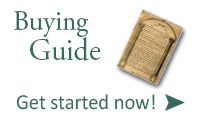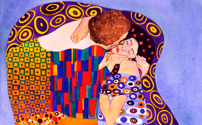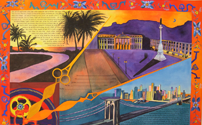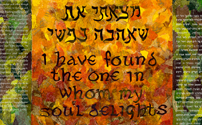
In 1998 my college roommate and best friend, Denise, and her fiance, Paul, asked me to paint them a ketubah as their wedding gift. Denise had a large influence upon me at Penn when she included me in her adult Bat Mitzvah and then invited me to travel with her in Israel in 1992. My conversion to Judaism, which she attended in early 1995, seemed completely natural and intuitive to her. She included me in her Jewish community and culture and I added depth to her learning as only a schooled convert can do. My Jewish wedding inspired her to include many religious elements in her own wedding. Painting Denise and Paul’s ketubah touched me deeply. Scenes of Israel and Nepal, where they would spend their honeymoon, Jewish symbols they had chosen, and bright colors poured through me. This was also my first experience writing in Hebrew. They loved the ketubah, which I was able to accompany all the way to their chuppah. The ketubah was a gift and, like any truly meaningful gift, the giver received bountiful recompense. My life was changed forever as a new career opened up before me.
We posted a photo of Denise and Paul’s ketubah on my website, Nishima.com, and soon I started receiving calls and commissions to hand-write and paint one-of-a-kind ketubahs regularly. The process of working with couples to co-create their visions was a great learning experience. Most couples had somewhat different tastes and ideas from each other, so I often played the role of counselor as we found ways to synthesize two unique individuals into one beautiful piece of art. Even when one partner was dominant, I found ways to draw out the other. What a blessing to be part of their pre-marital preparations! Many couples wanted a piece of art that had a connection to their favorite artist. I worked with multiple images from each artist, creating sketches so they could choose their favorite design or elements of design. We often added special flowers, colors, places, and symbols personal to them. These “modern art ketubahs” became the foundation of many of my designs for prints as I found great inspiration and also great satisfaction in adding my own artistry to interpreting master artists. Some couples wanted a ketubah design that primarily reflected their personal passions. The challenge I chose was to find a way to organize personal symbols, places, figures, etc. in truly unique ways for each couple. None of my “personal ketubahs” were alike. During these years I learned to write Hebrew well, expressing my love for this beautiful language through calligraphy and metallic inks. I also began to explore the wide world of ketubah texts.
In 2001 I began to explore producing limited edition ketubahs to better support my growing family. When I discovered a new process just emerging — gyclee printing — that allowed for creating each ketubah one-at-at-time, my intellectual passion for unique ketubah texts met my artistic passion for fine art that seamlessly integrated personalized texts (without hand-written fill-in-the-blanks of lithograph ketubahs). I enthusiastically began to develop art for my new gallery of ketubah designs. I also began to collect a wide range of ketubah texts and to study the meaning behind many of them. I spoke with several rabbis and authors of alternative texts for traditional Jews, writing a paper and using the information to elaborate “about” each text on my site. My goal is to host the largest collection of ketubah texts on the web, to make each available with any design, and to share these texts free of charge with all ketubah artists.
My current collection of fine art gyclee prints– limited edition ketubahs– is the result of my ongoing art-making. I work in series, developing a design or theme through several artworks per series. My work is varied because new challenges keep me stretching my abilities. This helps me grow as an artist and also results in more dynamic art. Of all the modern artists I explored while making hand-made ketubahs, I chose for my limited edition pieces to work with Klee, Klimt, Kandinsky, and Chagall (soon to be released). These artists’ lives and works speak to the sacred nature of art-making which to me reflects the sacred nature of marriage. My original works also touch themes and techniques– scenes of wild, expansive nature, iconic fruits and leaves, dancing lovers and trees, bright and vibrating color combinations, and textures of layered color and paper– that contain a vision of the spiritual. These call forth a response from the viewer, a relationship between the soul of each. Ketubah texts that speak of love, commitment and responsibility integrate into the designs of my images both visually and thematically because my ketubah artworks are created with marriage and conjugal devotion in mind, in heart and in soul.
In addition to making ketubahs, I am an active artist, writer, and parent. I work with clay to hand-build works that I cover with paper, paint, gold and silver leaf, beads, and sometimes words. I am developing a series of menorahs and other ritual objects using these techniques. I work with fabric using paint, stitching, beads, and Jewish letters, words, and symbols to create challah covers and sacred wall art. I draw and paint from life, working with figures, flowers, and landscapes. My writing influences my art through poetic story-telling that sometimes finds its way into my art through words as well as through imagery. My daughters, who live in the moment as only children can, demand loving attention that deepens me and my ability to be present to my artworks. I strive and work to create a Jewish home for them and this keeps me grounded in Judaism, the tradition that I have chosen to provide a specific framework for my lifelong spiritual search.






